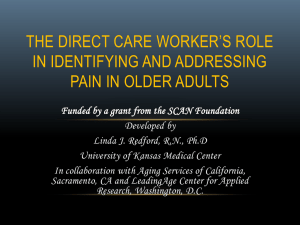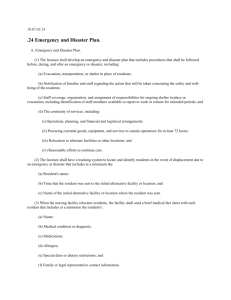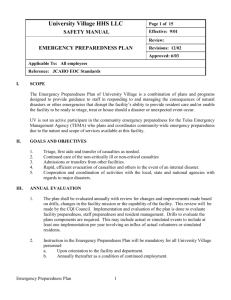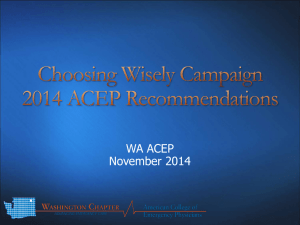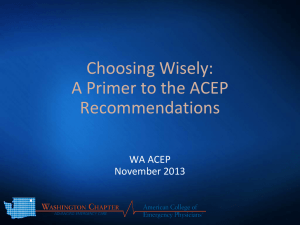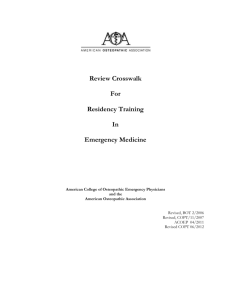2010_Disaster_Medicine_for_EM_Residents
advertisement
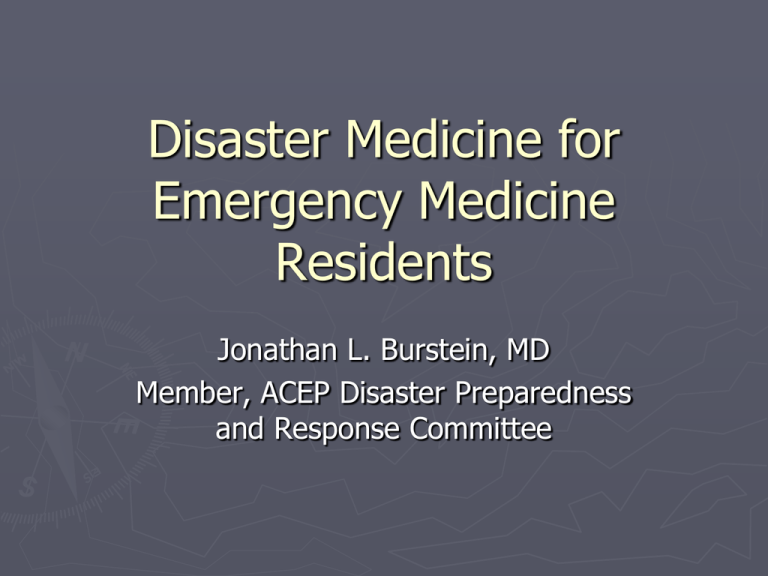
Disaster Medicine for Emergency Medicine Residents Jonathan L. Burstein, MD Member, ACEP Disaster Preparedness and Response Committee Haiti 2010 Disaster Training Proposals ► AAP ► ACS ► AAFP ► AMA NDLS program ► A”B”PS Disaster “Boards” Outside World ► Looking for medical experts Hospital admin EMS Public safety Government ► “First impressions and all that” Emergency Medicine and Disaster Medicine ► Natural role Patient triage and treatment Hospital-based EMS involvement ► Natural expertise We see everyone We see everything We look for things that aren’t there ► Perhaps an unnatural interest DM in the Core Curriculum ► Already included MCI EMS ID/pandemic/BT Hospital preparedness/admin Tox/chemical Crush/compartment Rad ► Not necessarily conjoint ► Not necessarily called out as DM DM in the Core Curriculum ► We ARE training residents as experts ► They just may not realize it ► And the materials may not be Coordinated Updated Interesting DM Uses for Residents ► Reinforces their sense of mastery ► Reminds them they have a role Patient care Hospital response Outside world (govt., military, NGO) ► Sparks interest in DM academics Fellowship training and research A junior faculty “niche” to develop ACEP Disaster Committee “Objective #3” Review and further define core curriculum in disaster medicine for emergency medicine residents and ► Develop/identify training materials for use by residency programs. ► ► Formalizing the core that exists Who Were We? ► ACEP and ACOEP A program director Two fellowship director A core faculty member An affiliate faculty member A resident ► Committee and ACEP/ACOEP BoD review Principles for Curriculum ► Based on review of existing material Eric Noji’s proposal of 1990 Textbooks Courses Fellowships ► 12 hours of material 1 grand rounds/major sesssion per year (4 hours) 3 year residency training program Resident Curriculum I. II. III. IV. V. VI. Challenges in Response to Disasters 1 hour Management of the Medical Response 1 hour Key Operational Capabilities 3 hours Special Needs Populations 1 hour Critical Medical Knowledge 5 hours Table Top Exercise 1 hour Resident Curriculum I. Common Challenges in Response to Disasters Common problems encountered during disasters ►Failure of communication systems ►Patient convergence Importance of drills Ethics and Legal Aspects ►Changes in ability to meet the standard of care Resident Curriculum II. Management of the Medical Response Incident management systems (NIMS, ICS) ►How physicians work with system for overall response The role of public health ►Mass dispensing of vaccines, medications Medical facility planning Resident Curriculum III. Key Operational Capabilities ► Pre-hospital operations Surge capacity planning ► ► Disaster triage HAZMAT/PPE/decontamination Staff/stuff/structure Medical system resilience (DMAT/USAR/SNS) Forensic issues Resident Curriculum IV. Special Needs Populations Identify vulnerable populations ► Elderly, pediatric, compromised, disabled, non-English-speaking Unique medical issues related to these individuals ►Medications/equipment/transfer agreements Evacuation of congregate facilities (nursing homes, etc) Social issues ►Family reunification/pets/sheltering Resident Curriculum V. ► Mass Critical Medical Knowledge trauma ► Structural collapse ► Burns ► Chemical exposure Nerve agents ► Radiation ► Infectious disease Bioterrorism Pandemic influenza ► Blast injury Resident Curriculum VI. Table Top Exercise Mass casualty triage exercise Activation and implementation of incident management system E.g. multiple casualties resulting from a terrorist bombing E.g. nursing home evacuation to the hospital Thank You Questions?






